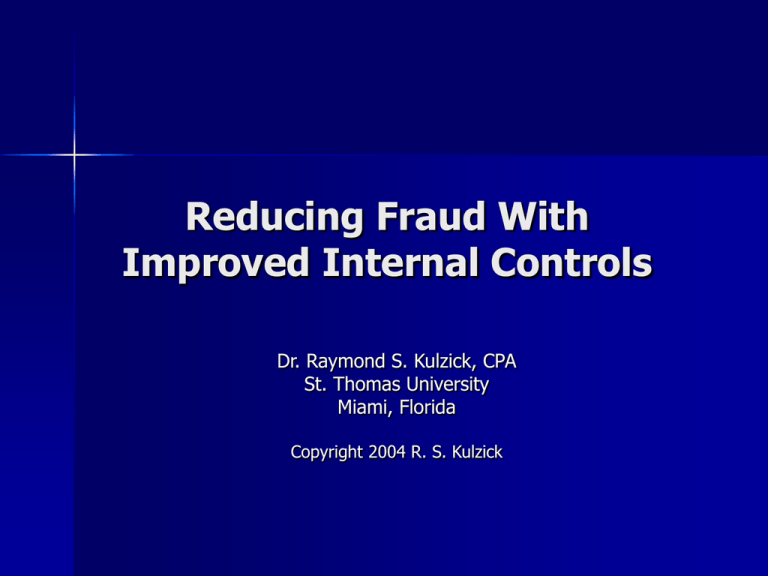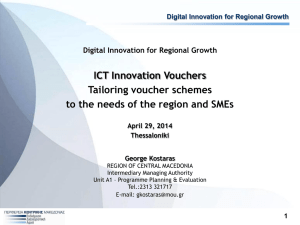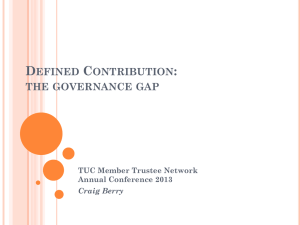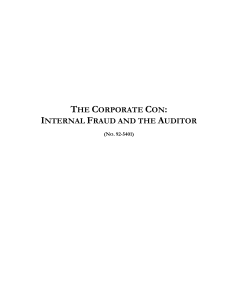Reducing Fraud With Improved Internal Controls
advertisement

Reducing Fraud With Improved Internal Controls Dr. Raymond S. Kulzick, CPA St. Thomas University Miami, Florida Copyright 2004 R. S. Kulzick Internal Control Definition and Purpose of Internal Control Process designed to provide reasonable assurance that the entity objectives are met Primary goal of internal control is to provide assurance that errors and fraud may be prevented and if not, discovered SAS 78 - Elements of Internal Control (CRIME) C = Control Activities R = Risk Assessment I = Information & Communication M = Monitoring E = Control Environment Who is responsible for internal control? Management is primarily responsible for internal control The board is ultimately responsible for internal control Auditors can assist others to meet their responsibilities, but they cannot assume those responsibilities themselves Types of Internal Controls Preventive controls Detective controls Corrective controls It is much more costly to discover errors and frauds with detective and corrective controls than it is to discourage them with preventive controls Internal Control Activities Independent Verification Access Control Segregation of Duties Accounting Records Supervision Transaction Authorization Independent Verification Reconciliations performed by third parties Regular inventories of physical assets Confirmations of receivables and payables Segregation of Duties Authorization separate from processing Custody of assets separate from the record keeping Successful fraud should require collusion between two or more individuals with incompatible responsibilities. Alternatives to Segregation of Duties Mandatory rotation of duties Mandatory vacation Analytical review Properly Designed Records Sequential numbering of documents Spoiled documents voided and retained Automatic duplicates of documents sent outside the originating dept. Effective Authorization Written policies and procedures governing who may authorize transactions “Authorization” must be obtained before, not after the fact Internal Control Inherent Limitations Only reasonable assurance Inadvertent errors can occur due to carelessness or misunderstandings Fraud or intentional misstatements can occur due to collusion or management override Internal Control Cost-Benefit Constraints The cost of an entity’s internal control should not exceed the benefits derived from the control. Common Schemes & Prevention Approaches Cash Accounts Receivable Inventory Purchasing Fixed assets Payroll Expense Reimbursements Cash Schemes Voids & under-rings Alteration of cash receipts documents Fictitious refunds & discounts Theft from deposits Kiting Cash Schemes Methods of Concealing Out of balance False debits – example paid outs False debit to asset - inventory Forced balance – incorrect credit Omitted credit – don’t count sale Cash Schemes Prevention Segregation of duties – Receipts, deposits, reconciliations & disbursements Job rotation & mandatory vacations Surprise cash counts Accounts Receivable Schemes Lapping Fictitious Accounts Receivable Old or written off A/Receivable Borrowing against A/Receivable Accounts Receivable Schemes - Concealing Destroyed records Lapping False statements to customers Write-offs Shift to inflated inventory Accounts Receivable Schemes Prevention Segregation of duties – Cash collection, posting A/R, writing off Lock-box Eliminate sales-based compensation Inventory Schemes Appropriating for personal use Theft of scrap or proceeds Charging embezzlements to inventory Inventory Schemes Prevention Proper documentation Segregation of duties – Requisition, disbursement, conversion to scrap, receipt of scrap proceeds Independent checks Physical safeguards Purchasing Schemes Fictitious invoices Over-billing Checks payable to employees, including duplicate payments Conflicts of interest Payment of personal expenses Purchasing Schemes Prevention Training within purchasing Proper documentation Proper approvals Segregation of duties Job rotation & enforced vacations Written policies Hotlines Competitive bidding Investments & Fixed Asset Schemes Use as collateral Borrowing to earn interest Theft of assets Personal use of assets Fixed Asset Schemes Prevention Segregation of duties – Custody, approval to sell, control of physical disposition, receipt of proceeds Periodic physical counts Payroll Schemes Ghost employees Commission schemes Overtime abuses & falsified wages Workers compensation schemes Withholding tax schemes Payroll Schemes Prevention Segregation of duties – Payroll preparation, disbursement, distribution, bank account reconciliation Periodic payroll review & analysis Expense Reimbursement Schemes Overstatement of expenses Duplication of expenses Fictitious expenses Personal expenses charged to organization Expense Reimbursement Schemes Prevention A strong ethics policy Require detailed expense reports with original receipts Use per diems Expense approval process Importance of Maintaining Adequate Internal Controls Management is responsible for maintaining adequate internal controls not the independent auditor. Fraud detected with preventive controls is less expensive. Don’t wait for fraud to happen before taking action. Sufficiently designed, implemented, and monitored internal controls can reduce the risk of loss by limiting opportunities and requiring collusion between two or more individuals. Some Common Red Flags for Fraud Lifestyle changes Significant personal debt and credit problems Behavioral changes – Drug or alcohol related – Gambling – Fear of losing job High employee turnover Refusal to take vacation or sick leave Lack of segregation of duties or other internal control weaknesses Some Simple Things For a Small Business 1 Pre-number & reconcile forms Screen prospective employees Segregate cash-related functions as much as possible Implement controls over checks Limit computer access Some Simple Things For a Small Business 2 Match invoices with checks Periodically review Accounts Receivable and Accounts Payable Receive unopened bank and credit card statements Be a good example Be aware for red flags Questions? Thanks for your attention. Ray Kulzick – 305.235.2154 rkulzick@stu.edu or rkulzick@kulzick.com










